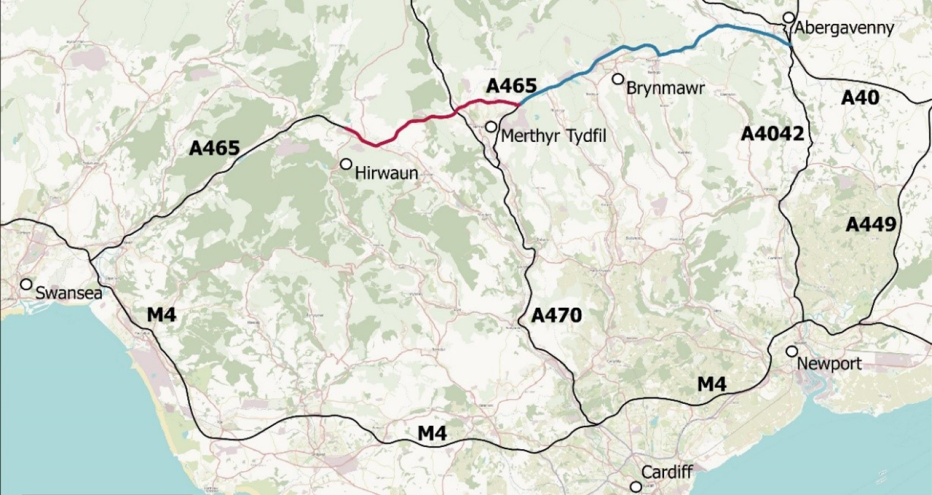
The scheme will improve road safety, reliability and travel times and includes extensive provision for active travel along the route. It is critical to the economic and social regeneration of the Heads of the Valleys area. Jacobs was the Welsh Government’s technical and procurement advisor for the scheme.
The Heads of the Valleys is one of the most distinctive areas in Wales, known for its rich industrial heritage, stunning landscape and close-knit communities. However, it is an area of high economic deprivation with low employment rates and lack of private investment. One of the key contributory factors is poor transport connections and accessibility to the rest of South Wales and the U.K.
The A465 is a key route in and out of the area and an important transport link in South Wales. Most of the A465 has been or is in the process of being improved to a dual carriageway, but Sections 5 and 6 (the 17km stretch between Dowlais Top, Merthyr Tydfil and Hirwaun) remain a single carriageway with at-grade junctions. These unimproved sections have a high accident rate, severe congestion and poor journey time reliability.
The Welsh Government appointed Jacobs as its technical and procurement advisor to progress the scheme through the statutory processes and advise on the suitability of the scheme for procurement using its new Mutual Investment Model (MIM).
Not only is the A465 the first project to be procured under the MIM model, it was also tendered in the middle of the COVID-19 pandemic. As a highly successful MIM pilot project, the scheme will deliver improved safety, reduced congestion and a range of community benefits.

The project encompassed dualling Sections 5 and 6 (coloured red in the above map) of the A465. Sections 1 to 4 (coloured blue) have already been dualled or, in the case of Section 2, are underway.
Mutual Investment Model: an innovative alternative to funding infrastructure schemes
With a scarcity of capital funding, the Welsh Government needed an alternative approach to finance major projects. So MIM was developed to support additional investment in social and economic infrastructure projects and help to improve public services in Wales.
Under MIM, a private sector Project Company will design, build and finance the proposed scheme and then operate it for a number of years. In exchange, the government will pay a monthly service payment to the Project Company during the operational period, enabling payment for the scheme to be spread over a longer period.
MIM projects should also be classified as “off balance sheet”, with payments taken from revenue rather than capital budget. This way, MIM provides a way of delivering infrastructure through revenue funding, leaving capital funding available to finance other alternative schemes and priorities.
MIM offers the following key features:
- the opportunity for the Welsh Government to take an equity stake (up to a maximum of 20%) in the Project Company, providing transparency at Board level and an opportunity for a share in any returns generated by the scheme;
- identification and focus on project specific community benefits; and
- enhanced stakeholder involvement through the right of the Welsh Government to appoint a director to the board of the Project Company.
Making the case for the scheme
Jacobs developed a concept design for the A465 Sections 5 and 6 dualling scheme to assess its costs, benefits and for the scheme to be progressed through statutory planning processes. To produce this design, Jacobs engaged with key stakeholders including local authorities, government agencies, environmental bodies, landowners and key interest groups, ensuring their needs were understood and potential impacts of the scheme minimized.
We took this concept design through the Statutory Process, producing relevant documents to make the case for the scheme (including an Outline Business Case, draft Orders, Environmental Statement and Statement of Case) which were made available to the public. The Outline Business Case demonstrated that MIM form of procurement offered best value for money.
We managed the Public Local Inquiry (PLI), where members of the public were able to present their views and objections to an independent inspector and question the Welsh Government and our experts. We also provided an innovative virtual reality model that allowed the public and other stakeholders to see how the scheme would look. The 3D model enabled them to visualize and better understand the impacts of the scheme on people, properties and the environment.
Following the PLI, the independent inspector reviewed the evidence for and against the scheme, and recommended it should go ahead.
-
1 K
injury accidents estimated to be saved in the next 60 years
-
1.6 K
national qualifications, leaving a legacy of improved skills
-
£ 400 M
of direct spend in Wales
-
£ 755 M
of gross value added for the U.K.
Innovation and value for money
With the successful completion of the Statutory Process, the scheme was then taken through procurement, becoming the first project to be procured under the MIM model.
Under the A465's MIM contract, procurement is via a competitive dialogue process with up to three pre-qualified bidders. During that period, the bidders individually meet with the government and discuss technical and commercial matters. At the end of dialogue, the bidders are invited to submit their Final Tenders.
This competitive dialogue approach allows the bidders time to develop their designs in consultation with the government and key stakeholders. This process affords time to the bidders to consider innovative designs that can deliver more value for money, support better social outcomes and be acceptable to the key stakeholders.
Under MIM, the Project Company will operate and maintain the road for 30 years after building it. This helps ensure attention to the quality of construction given the Project Company will also cover maintenance costs during the contract period. The contract includes robust hand back requirements to ensure that the Project Company returns the road to the government in a good condition. This provides additional reassurance to the government that the designed solution has an optimal whole-life cost.
A successfully procured project
Jacobs successfully led the procurement process in collaboration with the Welsh Government and its legal, financial and insurance advisors, drawing on its extensive experience in procuring Public-Private Partnership contracts in the U.K. and worldwide.
The competitive dialogue was held with three major private consortia including Welsh, national and international organizations. Managing this process, Jacobs developed the procurement documents, managed meetings with bidders, reviewed their draft proposals, obtained government approvals and managed the web-based procurement portal for confidential exchange of documents and questions & answers.
After the dialogue ended, we supported Welsh Government in the evaluation of final tenders and managed the process from successful bidder announcement to financial close. This included the completion of the Full Business Case that demonstrated the scheme case remained strong and that it provided value for money.
Following Ministerial approval, the contract was signed with the successful bidder (the Future Valleys consortium) in October 2020.
Not only was the A465 the first project to be procured under the MIM model, but it was also tendered in the middle of the COVID-19 pandemic and Brexit uncertainty. The A465 has therefore been a highly successful MIM pilot project providing a wealth of best practice and opportunities for procuring further schemes under this model to boost the Welsh economy.
This success has not gone unnoticed, with the project being awarded "Europe PPP Deal of the Year 2020" by Project Finance International and “Europe Transport Deal of 2020” by IJGlobal.
“Jacobs’ ability to provide a wide range of services and expertise, covering the design, statutory process, PPP procurement and expert local knowledge was a key factor in the procurement’s success. The Jacobs team’s professionalism and understanding of the competitive dialogue process enabled the Welsh Government’s objectives to be met in a timely manner against the headwinds of Brexit, market uncertainty and COVID-19.”
A range of benefits to the local, Welsh and UK economy
The scheme will improve safety, with the dualling of the road and grade-separated junctions. It also includes extensive active travel measures including over 14 kilometers of new segregated route for non-motorized users, improving links and travel safety within the communities and enhancing recreational routes in the area. Overall, it is expected to reduce injury accidents by over 1,000 in the next 60 years.
The project will also address the growing congestion in Sections 5 and 6 and reduce journey times. It will improve reliability and connectivity between key local communities in the area and the economic centers in South Wales and the Midlands, and enhance the resilience of the South Wales transport network.
The scheme is expected to generate around £400 million ($560M) of direct spend in Wales and result in £675m ($940M) gross value added for Wales and £755m ($1 billion) for the UK.
Community benefits is a key feature of MIM contracts, where the Project Company is required contractually to deliver specific community benefit targets. Scheme benefits will include over 120 apprenticeships, 60 traineeships, 310 internships and over 1,600 national qualifications leaving a legacy of improved skills in an area of high economic deprivation. It will also provide an opportunity for continuous employment to workers involved in the construction of previous sections of the A465 improvements.
With the scheme being delivered via MIM, the Welsh Government‘s payments should be minimal until construction is completed. As a result, in the immediate post-COVID post-Brexit 4-year period, the Welsh Government will get a full range of community benefits and economic stimulus from the project for a relatively modest contribution.
Awards
- Europe PPP Deal of the Year 2020 (Project Finance International)
- Europe Transport Deal of 2020 (IJGlobal)














































